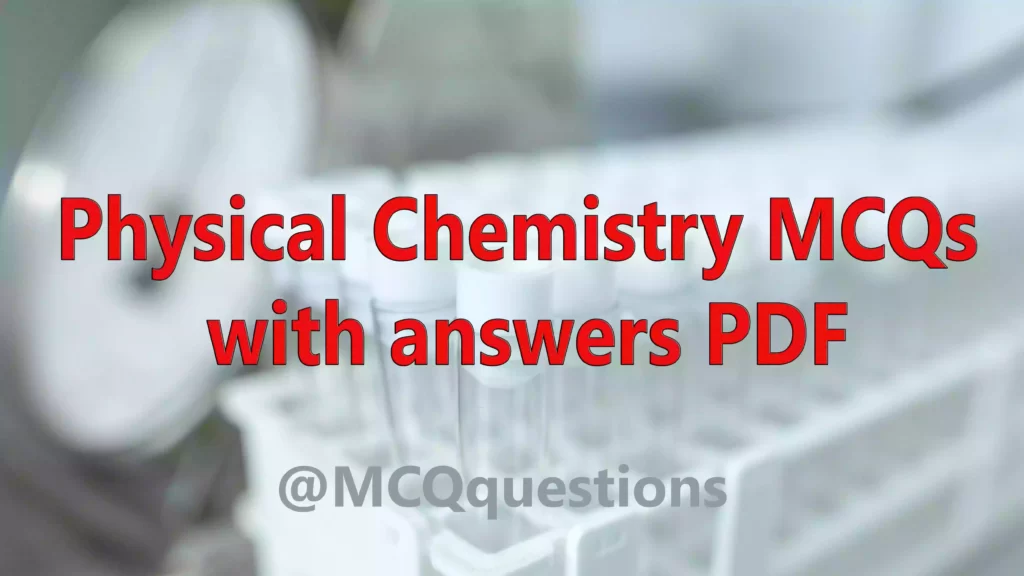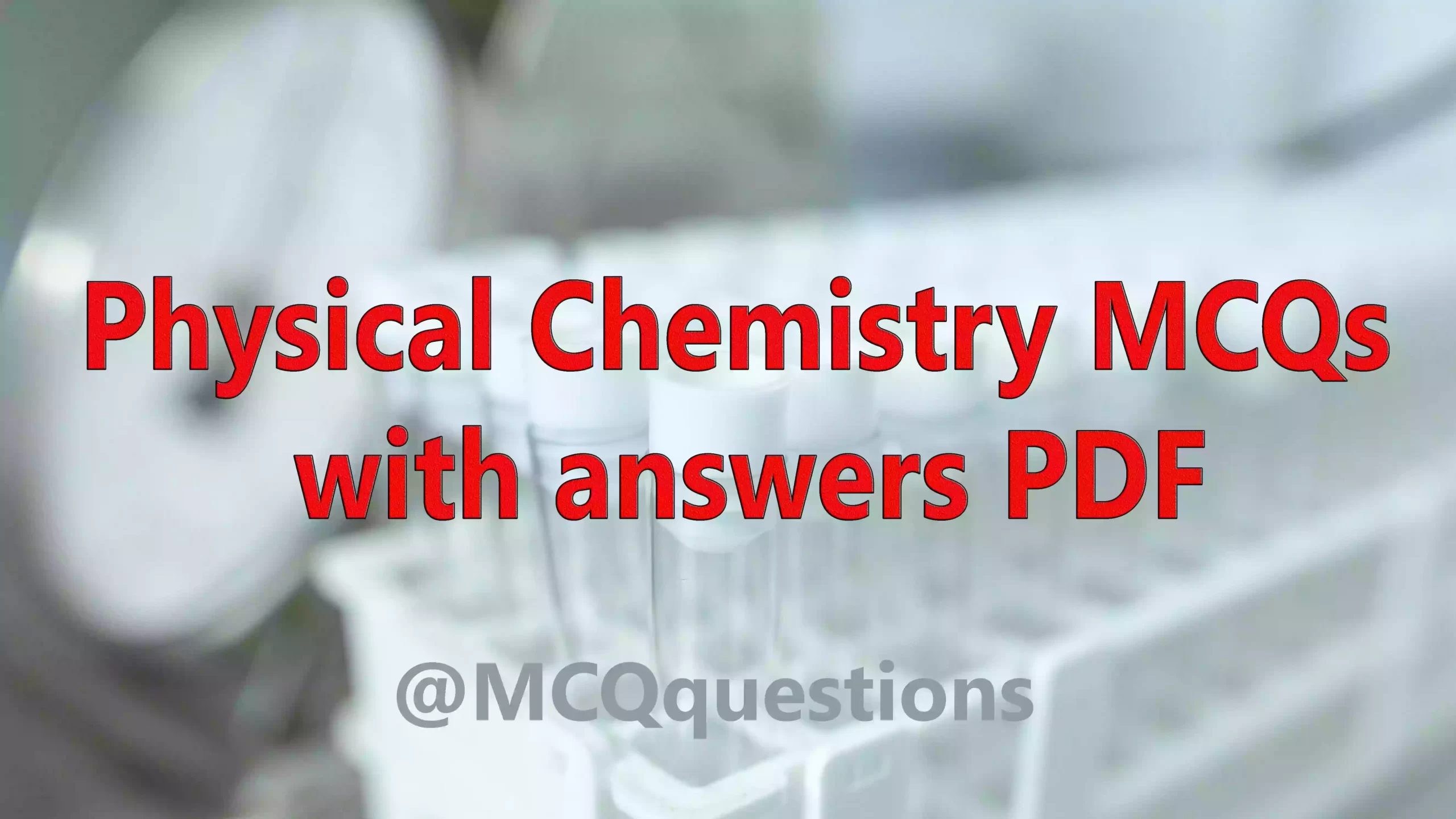Physical Chemistry MCQ on Liquid State PDF
Physical Chemistry MCQs – 1

Physical Chemistry MCQs with answers PDF
1. The boiling point at pressure 1 atm is called
(a) Standard boiling point
(b) Normal boiling point
(c) Van der Waal boiling point
(d) Saturated boiling point
Answer: (c) Van der Waal boiling point
2. Viscosity of liquid _________ with rise in temperature.
(a) Increases
(b) Decreases
(c) Remains constant
(d) Is independent
3. Path in liquid in which layers do not meet each other is _______
(a) laminar flow
(b) tubular flow
(c) viscosity
(d) straight path
4.What is S.I. unit of Surface Tension?
(a) Dyne/meter
(b) Newton-meter
(c) Newton/meter
(d) Dyne-meter
5. A water drop is spherical in shape due to ____________
(a) Viscosity
(b) Poise
(c) Surface tension
(d) Reflection
6.At critical temperature,the surface tension will be
(a) one
(b) zero
(c) two
(d) three
7. Higher the viscosity, the slower the liquid flows.
(a) True
(b) False
8. : The vapor pressure is directly proportional to the temperature because of
(a) more kinetic energy only
(b) faster particle movement only
(c) more potential energy
(d) more kinetic energy and faster particle movement
Answer (d) more kinetic energy and faster particle movement
9. When the movement of water molecules in liquid becomes equal to the molecules in vapor form, a state is called
(a) equilibrium
(b) constant
(c) ideal
(d) non-ideal
10.The state of freezing involves
(a) loss of kinetic energy
(b) increased force of attraction
(c) liquid solidifies
(d) all of above
1. The boiling point at pressure 1 atm is called
(a) Standard boiling point
(b) Normal boiling point
(c) Van der Waal boiling point
(d) Saturated boiling point
Answer: (c) Van der Waal boiling point
2. Viscosity of liquid _________ with rise in temperature.
(a) Increases
(b) Decreases
(c) Remains constant
(d) Is independent
3. Path in liquid in which layers do not meet each other is _______
(a) laminar flow
(b) tubular flow
(c) viscosity
(d) straight path
4.What is S.I. unit of Surface Tension?
(a) Dyne/meter
(b) Newton-meter
(c) Newton/meter
(d) Dyne-meter
5. A water drop is spherical in shape due to ____________
(a) Viscosity
(b) Poise
(c) Surface tension
(d) Reflection
6.At critical temperature,the surface tension will be
(a) one
(b) zero
(c) two
(d) three
7. Higher the viscosity, the slower the liquid flows.
(a) True
(b) False
8. : The vapor pressure is directly proportional to the temperature because of
(a) more kinetic energy only
(b) faster particle movement only
(c) more potential energy
(d) more kinetic energy and faster particle movement
Answer (d) more kinetic energy and faster particle movement
9. When the movement of water molecules in liquid becomes equal to the molecules in vapor form, a state is called
(a) equilibrium
(b) constant
(c) ideal
(d) non-ideal
10.The state of freezing involves
(a) loss of kinetic energy
(b) increased force of attraction
(c) liquid solidifies
(d) all of above
Physical Chemistry MCQ on Chemical kinetics PDF
Physical Chemistry MCQs – 2
1. The rate of a chemical reaction talks about
(a) The reactants and products taking part in the reaction
(b) The products formed in the reaction
(c) Speed of the reaction
(d) None of the above
Answer (c) Speed of the reaction
2. When the concentration of reactants is unity then the rate is equal to
(a) Specific rate constant
(b) Average rate constant
(c) Instantaneous rate constant
(d) None of the above
Answer: (a) specific rate constant
3. In which state the average rate and instantaneous rate of a reaction are equal
(a) At the start
(b) At the end
(c) In the middle
(d) When two rates have a time interval equal to zero
Answer: (d) when two rates have a time interval equal to zero
4. Choose the incorrect one
(a) Order of a reaction is always a whole number never a fraction
(b) The order of the reaction is does not affected by its stoichiometric coefficient
(c) Order of reaction is may be a whole number or fraction
(d) Order can only be assessed experimentally
Answer: (a) Order of a reaction is always a whole number never a fraction
5. The unit of rate constant of zero-order reactions is
(a) s-1
(b) mol L-1 s-1
(c) L2 mol-2 s-1
(d) L mol-1 s-1
Answer: (b) mol L-1 s-1
6. In the reaction 2A + B → A2B, if the concentration of A is doubled and that of B is halved, then the rate of the reaction will
(a) Increase 2 times
(b) Increase 4 times
(c) Decrease 2 times
(d) Remain the same
Answer: (a) increase 2 times
7. What will be the order of the reaction if, the rate of the reaction is equal to the rate constant,
(a) Zero order
(b) First order
(c) Second order
(d) Third order
Answer: (a) zero order
8. The catalyst use in the Haber process is
(a) Platinized asbestos
(b) Iron with molybdenum as a promoter
(c) Copper oxide
(d) Alumina
Answer: (b) Iron with molybdenum as a promoter
9. A catalyst alters,
(a) Entropy
(b) Enthalpy
(c) Internal energy
(d) Activation energy
Answer: (d) Activation energy
Physical Chemistry MCQ on Thermodynamics PDF
Physical Chemistry MCQs – 3
1. Foe which thermodynamic process the change in enthalpy is zero?
(a) isothermal
(b) isochoric
(c) isobaric
(d) adiabatic
Answer: (d) adiabatic
2. What is the value of gamma for gas if the pressure of the gas is proportional to the T³ for adiabatic process ?
(a) 2
(b) 3/2
(c) 4/3
(d) 5/3
Answer: (b) 3/2
3. The coefficient performance of a refrigerator is 5. Calculate the heat emitted to the surrounding if the temperature inside system is -20⁰c.
(a) 11oC
(b) 41oC
(c) 21oC
(d) 31oC
Answer: (d) 31oC
4. According to Kirchhoff equation Which of the following factor affects the heat of reaction
(a) molecularity
(b) temperature
(c) pressure
(d) volume
Answer: (b) temperature
5. Chemical dissociation is
(a) exothermic
(b) reversible
(c) endothermic
(d) reversible and endothermic
Answer: (d) reversible and endothermic
6. The largest unit of energy is
(a) electron volt
(b) joule
(c) calorie
(d) erg
Answer: (c) calorie
7. Aunique characteristic feature of perfect black body is
(a) a good absorber only
(b) a good radiator
(c) a good absorber and a good radiator
(d) neither a radiator nor an absorber
Answer: (c) a good absorber and a good radiator
8. The thermodynamic process where heat cannot be exchanged within system and surrounding is
(a) isothermal
(b) adiabatic
(c) isobaric
(d) isotropic
Answer: (b) adiabatic
9. The law that was formulated by Nernst is
(a) First law of thermodynamics
(b) Second law of thermodynamics
(c) Third law of thermodynamics
(d) None of the above
Answer: (c) Third law of thermodynamics
